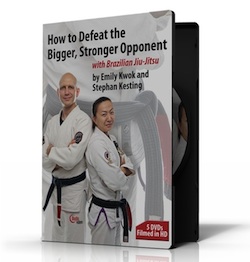Back in the late 80's, I accompanied Rigan Machado from LA down to Rio in Brazil for a months training 'on the mat'; after which I think I wrote the first articles on such for Blitz magazine. At that time, very few in the 'states' and almost no-one out here had even heard of this now notorious Brazilian system. Back then, one would be lucky to find a grappling-based article featured in one out of every ten martial arts publications. Now though, we are seeing whole issues being devoted to the topic ... times have certainly changed!
As a result of this increased awareness of the effectiveness of grappling, and more likely, as a result of an increasing 'demand' for ground techniques by the public, we see grappling instructors crawling out of the woodwork. A few have something good to offer, many have a very limited knowledge on the subject, most haven't a clue. The hope though, is that more and more are at least willing to broaden their horizons and are doing all they can to find out more about it, and if so then, 'more power to them!'
In this article, I hope to offer something for both 'camps'. That is, more info for those who have a genuine interest in grappling; and something also for those also who feel threatened by this 'new wave' and who feel that somehow it devalues their longtime investment in the arts they already practice. For the latter, I offer my arguments on 'when not to grapple' ... some of which you may find handy to regurgitate from time to time.
APPROPRIATE SCENARIOS:
(WHEN TO GRAPPLE)
THE 'CHALLENGE': The 'challenge', or the 'one on one' contest between two people, doesn't necessarily have to be 'confrontational'. Although these types of challenges occur, many are also just a form 'trial by combat' between two people, to determine either the style or the individuals effectiveness as a fighter. These are an important aspect of the serious martial artists training and development. In some training places, this occurs on a daily basis; and so brings the question of effectiveness into sharp focus.
In the 'one on one' challenge (or 'the fair go on the common' - as Geoff Thompson puts it), grappling is definitely a 'proven winner'. The reasons for this are several, but the main one being that once the floor hits the ground, which on many occasions it will do, then the person with all the years invested in 'stand-up' only training, is basically left with nothing to do. The grappler however, is just starting to get to work. It really is that simple, and most people would agree.
PUT IT TO THE TEST!
What people do find objectionable though, is the very idea that they could be 'taken down' in the first place. 'But I would just kick him in the groin, and that would be that" they say! Hmmm, ever tried that, with maybe twenty dollars riding on the outcome? Even with a fellow training partner, who also believes the same thing? Try it, make a bet, maybe a meal at a restaurant or a 'shout' to the movies, if your partner gets you down! Be ready though, to part with those hard-earned pounds. It's easier than many think.
The reason that people are frequently shocked by the fact that they can't knock the other guy out before the clinch, is that they simply have never trained to avoid it. Most people simply play the same game as their training partner plays, IE: Taekwondo players mutually agree to stand apart and throw techniques at each other (no offence intended guys) as do karateka, boxers, kickboxers, fencers, etc. Most do not train to effectively, and on a daily basis, to stop someone who genuinely wants to get in and grab a hold of them. Hence the big surprise when it happens.
THE REALITY: IN MANY NO-RULES ENCOUNTERS, THE GRAPPLER WILL CLINCH BEFORE THE KNOCK-OUT OCCURS. IF THAT HAPPENS, THE PURIST STAND-OFF FIGHTER HAS EVERYTHING STACKED AGAINST HIM.
BEST BETS: FOR THE STAND-OFF FIGHTER, MOVE AND DELIVER SHOTS WITH 'KO' POTENTIAL EVERY TIME. DON'T WAIT! FOR THE GRAPPLER, COVER UP, WORK YOUR DISTANCE WELL, COMMIT TO THE CLINCH, CRASH IN HARD.
THE ARREST PROCEDURE: Provided it is not a one against many situation, then grappling is an appropriate answer for many situations that arise during law enforcement procedure. Officers engaged in law enforcement cannot afford to stand back and 'punch' it out with an offender for several reasons:
1. It can often take to long, allowing other suspects to get away, or worse, better prepare themselves for 'deadly resistance'.
2. It is both more 'court' and 'media' friendly to grapple an offender and make arrest than to beat him/her into submission (even though he /she are violently resisting).
3. Grappling is simply more efficient, the altercation is less likely to develop into a three round blood fest; it more likely to be brought to a conclusion within a short time.
4. Once brought to the ground, the ensuing struggle is contained to a single location, as opposed to an ongoing fight that may take the officer further from his/her support network; i.e.: car, radio, other officers, etc.
5. The Rodney King scenario (widely publicized arrest in the U.S.A) is a perfect example; if officers in that situation were allowed to apply a 'choke', or knew how to grapple, the situation would have been over in seconds. Millions of dollars would also have been saved in court costs.
Home » martial arts » Brazilian Jiu-Jitsu Bandung : grapple or not - Dilemma - One
Brazilian Jiu-Jitsu Bandung : grapple or not - Dilemma - One
12:52 AM
Unknown
Label:
bandung,
brazilian jiu-jitsu,
English,
english version,
martial arts

